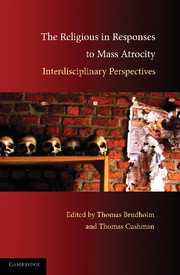Book contents
- Frontmatter
- Contents
- List of Contributors
- Acknowledgments
- Introduction: The Religious in Responses to Mass Atrocity
- Part I Between Necessity and Impossibility: The Role of Religion in the Face of Atrocity
- Part II Does It Help to Import Religious Ideas: Reflections on Punishment, War, and Forgiveness
- Part III Sociologies of the Religious in Responses to Mass Atrocities
- 7 Making Whole: The Ethics and Politics of “Coming to Terms with the Past”
- 8 When Faith Meets History: The Influence of Religion on Transitional Justice
- 9 Genocidal Rupture and Performative Repair in Global Civil Society: Reconsidering the Discourse of Apology in the Face of Mass Atrocity
- 10 Violence, Human Rights, and Piety: Cosmopolitanism versus Virtuous Exclusion in Response to Atrocity
- Index
10 - Violence, Human Rights, and Piety: Cosmopolitanism versus Virtuous Exclusion in Response to Atrocity
Published online by Cambridge University Press: 01 September 2009
- Frontmatter
- Contents
- List of Contributors
- Acknowledgments
- Introduction: The Religious in Responses to Mass Atrocity
- Part I Between Necessity and Impossibility: The Role of Religion in the Face of Atrocity
- Part II Does It Help to Import Religious Ideas: Reflections on Punishment, War, and Forgiveness
- Part III Sociologies of the Religious in Responses to Mass Atrocities
- 7 Making Whole: The Ethics and Politics of “Coming to Terms with the Past”
- 8 When Faith Meets History: The Influence of Religion on Transitional Justice
- 9 Genocidal Rupture and Performative Repair in Global Civil Society: Reconsidering the Discourse of Apology in the Face of Mass Atrocity
- 10 Violence, Human Rights, and Piety: Cosmopolitanism versus Virtuous Exclusion in Response to Atrocity
- Index
Summary
Introduction: Fellow Feeling and Its Limitations
There is a well-established argument in moral philosophy and to some extent in political economy that human beings qua human beings have a strong sentiment of sympathy for others. In 1759 Adam Smith who was then the professor of moral philosophy at the University of Glasgow published his The Theory of Moral Sentiments in which he had much to say about “fellow feeling.” It is worth quoting Smith at some length on this issue, since his views have to some extent remained definitive on the topic:
Humanity consists merely in the exquisite fellow-feeling which the spectator entertains with the sentiments of the persons principally concerned, so as to grieve for their sufferings, to resent their injuries, and to rejoice at their good fortune.
(Smith, 1984, pp. 190–191).David Hume took a similar view in writing the three volumes of the Treatise on Human Nature (1958) in the 1730s. For Hume
A good natur'd man finds himself in an instant of the same humour with his company. … A cheerful countenance infuses a sensible complacency and serenity into my mind
(Hume, 1958, p. 317).But Hume noted that when I feel sympathy for a child who has injured him self, I do not actually feel pain and hence he reasoned that sympathy or the ability to sympathize with the mood of a fellow human being is in fact the basis of morality as such.
- Type
- Chapter
- Information
- The Religious in Responses to Mass AtrocityInterdisciplinary Perspectives, pp. 242 - 264Publisher: Cambridge University PressPrint publication year: 2009

